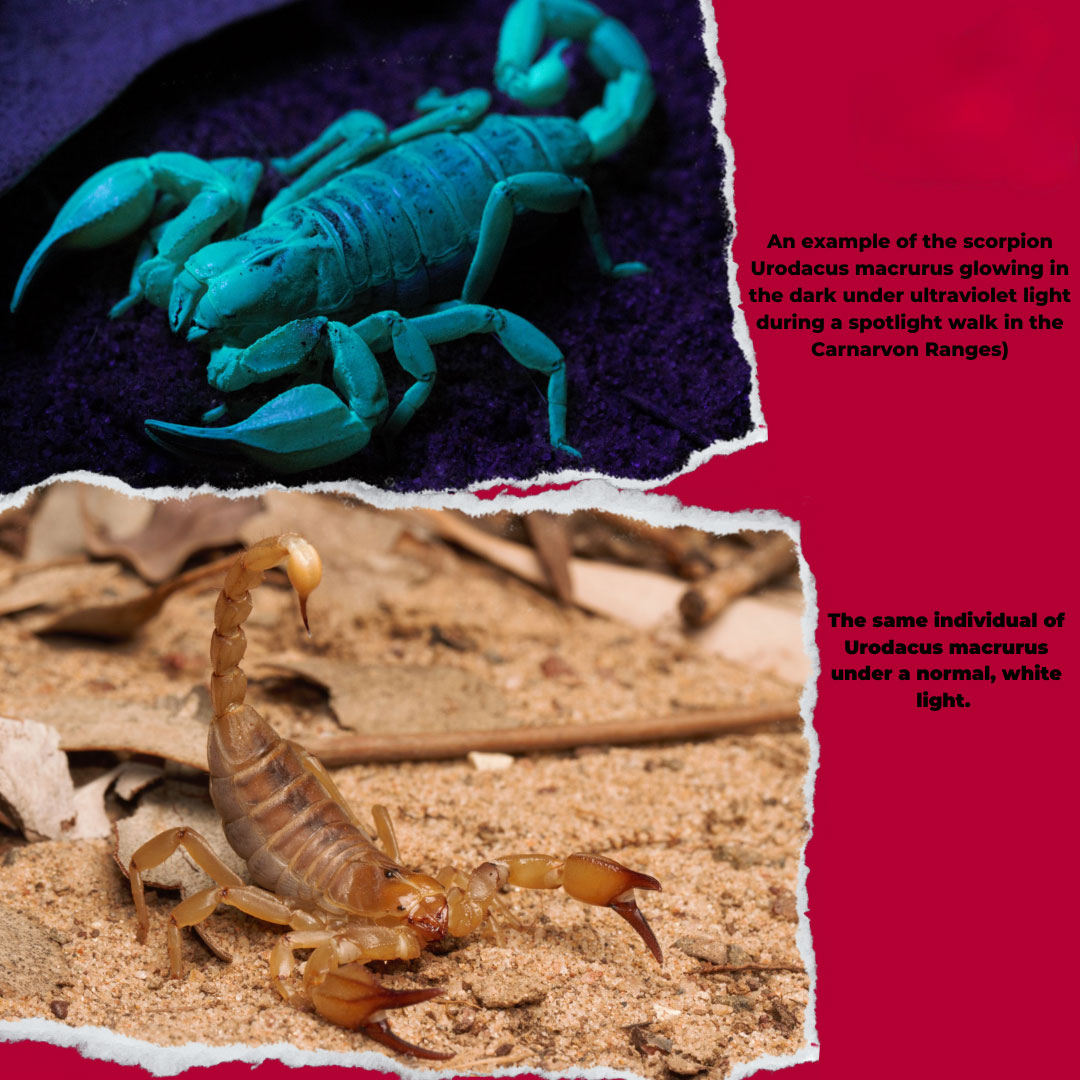
When the sun goes down in the Australian outback a completely new suite of animals come out of hiding. This includes Urodacus macrurus, a large (up to 10cm in length) species of scorpion that occurs throughout central Queensland. These scorpions avoid the harsh sun during the day bunkered down in their burrow. Instead, they prefer to emerge under the cover of darkness when it is cooler and they’re less visible to predators. Urodacus macrurus constructs a spiral burrow in sandy soils that can reach over 40cm in depth, which it can dig in a single night. The burrow and spiral structure are important adaptations for temperature management and maintaining humidity in harsh, arid conditions.
These scorpions are ambush predators. During the night they will sit at the entrance of their burrow waiting for an invertebrate prey item to walk past, such as a cricket, moth, spider or even a smaller scorpion. Prey is subdued using their powerful pincers which hold the invertebrate in place while the scorpion uses its venomous sting at the end of the tail to deliver the final blow. The scorpion will retreat down its burrow to enjoy its meal in peace.
During the night, male scorpions will leave their burrow in search of females. Mating is a complicated process involving a courtship ‘dance’ where the male tries to avoid being killed and eaten by a potentially hungry, aggressive female while persuading her to mate. Scorpions in the genus Urodacus have surprisingly long gestation periods; ranging from 12 to 18 months. Females give birth to live young, which once born climb on to the mother’s back where they stay until after their first moult. Once their exoskeleton (outer skin) has hardened, the young scorpions leave their mother’s back and they are then entirely independent and receive no further maternal care.

Unlike a lot of other Australian wildlife which are considered to be some of the most toxic/dangerous in the world, Australian scorpions do not rank highly in terms of venom potency to humans. No Australian scorpions are considered dangerous. However, a sting from U. macrurus may pack quite a punch, resulting in localized pain, redness and swelling.
One of the most unique and mystifying features of scorpions, including Urodacus macrurus, is their ability to glow under UV light. The scientific term for this phenomenon is fluorescence. This big word describes the process when light strikes an object which re-emits that light at a different wavelength. In the case of scorpions, the purple light of the UV torch hits the scorpion and is re-emitted as a cyan-green light. The substance that fluoresces is contained within the scorpion’s hard cuticle (outer skin). Even fossilized scorpions will glow under a UV light. Using a black light on a dark night, scorpions can be observed from many meters away, making them very easy to find if they are in the area. This is very useful for scientists researching scorpions. You may be surprised (or horrified) to see the densities at which scorpions can occur in a relatively small area!
Numerous hypotheses have been proposed to explain why scorpions possess fluorescent capabilities. It has been suggested that it may assist scorpions in locating and recognising potential mates and aid in courtship rituals. It could have evolved as a form of ‘sunscreen’ in response to increased UV light exposure during the time of scorpion evolution when there was more oxygen in the Earth’s atmosphere. Another hypothesis suggests that scorpion’s fluorescent abilities act as a giant eye. When the scorpion is peeking out of its burrow at night it can detect how much of its body is exposed based on the UV light hitting the scorpion from the moonlight. It has also been suggested that this unique trait actually serves no deliberate purpose and the fluorescent chemicals in the cuticle are a metabolic by-product. Ultimately, no one knows for sure what benefits scorpions derive from glowing under UV light. Maybe you can come up with a theory of your own?
Next time you’re out in the bush camping you might want to bring a black light so you can see who you’re sharing your campsite with!
Are you interested in learning more about scorpions and seeing them glow in the dark, join in the hunt for scorpions in the Carnarvon Ranges during one of our Eco science expeditions? See our website for more details.

